I’m sure there are some people who, very early on in their lives, work out what they want to do and then set out single-mindedly to achieve their aims. For the rest of us, choices are made and paths are set without us really being conscious of those junctions, so we look back and wonder how was it that our lives unfolded in this way and not in another. And yet, looking back, we sometimes can see moments, or short periods, that were decisive in setting us down one path and cutting off other possibilities. For me, the summer of 1982 was the time that determined that I was going to end up being a scientist, and to some extent what sort of scientist I would end up being, though I don’t suppose at any moment at the time I had any idea that this was the case.
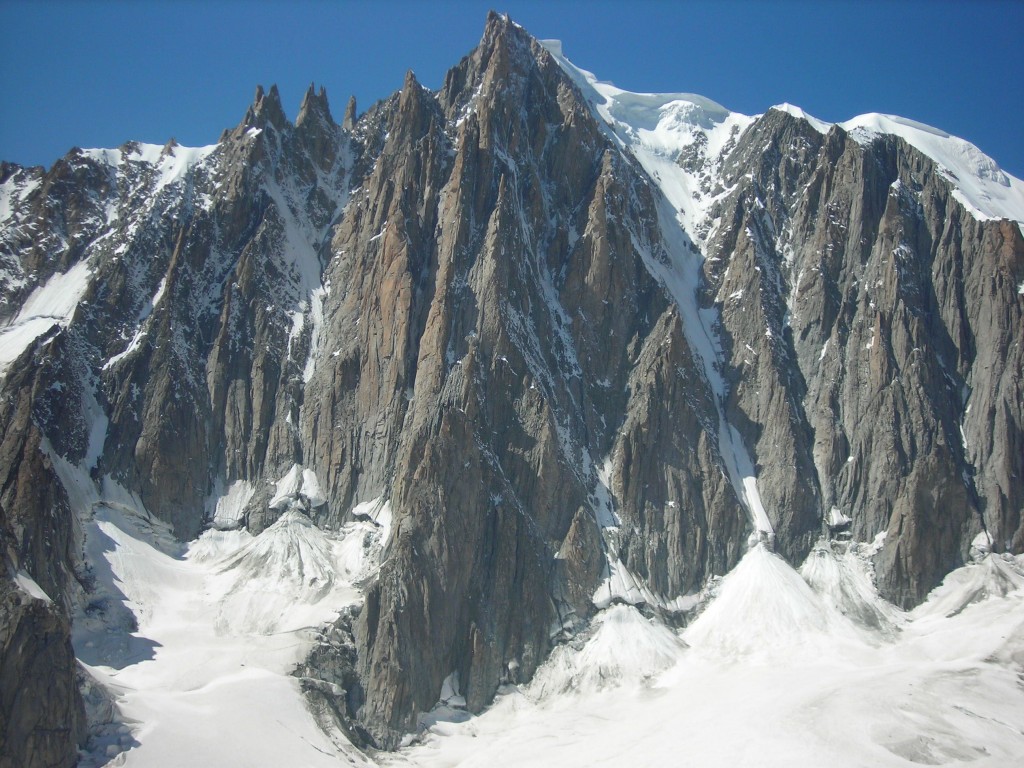
The East Face of Mont Blanc du Tacul, a 4,248 m peak in the French Alps
It began on the bus to Chamonix, in the French Alps, in the summer vacation after my second year at University. I’d not done too badly, but I’d probably admit that physics wasn’t the only thing that interested me. I’d discovered rock climbing as a teenager, and that had led on, as it sometimes does, to bigger, snowier mountains. This would be my second trip to the Alps, with my old friend from school, Mark Miller. We’d learnt to climb together, starting on the short, but technically demanding, cliffs of the Peak District, later moving on to the bigger and more serious routes in Britain’s mountains and sea cliffs. The summer of 1981 had seen our first trip to the Alps. Then we’d spent 6 weeks climbing some of the classic routes of the Chamonix Aiguilles and the Mont Blanc range, setting out on some serious undertakings with what seems in retrospect an excess of enthusiasm, laughably inadequate equipment and a terrifying lack of experience. Nonetheless, we’d made our mistakes and survived them, and on this second trip we were confident, fit and between us we’d found some half-way decent gear.
We’d already chosen our first route, on Mont Blanc du Tacul – it was to be the Albinoni-Gabarrou Couloir. This is now one of the most frequently ascended pure ice routes in the Mont Blanc range, but at the time it still had a little bit of mystique, with only a few lines of description (and a high grade) in the “New Climbs” section of the English guidebook. We’d unstiffened ourselves from 24 hours on the bus, put our tent up on Snell’s Field, the unofficial, free (and squalid) camp site favoured by the impecunious British alpinists and the even poorer East Europeans, and got ourselves up to the base of the dramatic east face of the mountain one evening. A few hours of mixed sleep and shivering on the glacier, a gritty cup of tea, and then we were off by the light of our head torches for a pre-dawn start.
A few hundred meters of steep, but not vertical, snow-ice brought us by first light to the start of the real technical difficulties – a runnel, perhaps 5-10 feet wide, filled with a ribbon of perfect blue ice. The climbing was steep, but the picks of my new ice tools sank in securely and I felt confident with my weight on the front points of my crampons. The solid red granite provided secure stances, and soon we were on the top of the route. It wasn’t the first time I’d been to the top of Mont Blanc du Tacul – the previous year I had climbed the Gervasutti Pillar, a classic 800 meter rock route on the same face. I’d done that, not with Mark, but with a partner I’d met in the campsite and didn’t know well, and we’d probably bitten off more than we could chew. It had been well past sundown, 11 pm or so, that we’d made it to the summit, so it hadn’t been until the small hours, perhaps 20 hours after we’d started the route, that we finally collapsed in the shelter and safety of the Abri Simond (a derelict shack favoured as a high bivouac by the same demographic that used Snell’s Field). This time was different – Mark and I were on the top by mid-morning, so thanks to the cable-car from the Aiguille du Midi we were back in Chamonix in time for a lunch-time beer in the Bar National, surely the very definition of a smooth and fast alpine ascent.
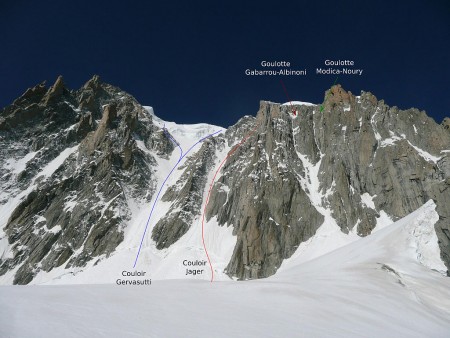
Snow and ice routes on the East face of Mont Blanc du Tacul. Credit: Thomas Charbonneau, Creative Commons CC-by-sa
Our next route was to be a rock climb, and Mark and I did it with two Australians we’d met in the camp site – Jon Muir and Mark Moorhead. They were a very funny pair, very good company – and truly world-class climbers; we didn’t know it then, but Mark Moorhead especially was one of the best rock climbers in Australia at the time. The route we did – the Cordier Pillar on the Grands Charmoz – wasn’t hard by their standards – in English grades, it would perhaps count as HVS-E1 (but there are more than 20 pitches of it). But it was a pleasure to do the route smoothly and fast and for me to feel that I was able to keep up with such obviously talented climbers. We were off the route by mid-afternoon, and once again there was a marked contrast with the previous year. Then, with Mark, I’d had a difficult descent down the dangerous Nantillons glacier, after an ill-starred ascent of the Aiguille de Grepon that had culminated in Mark dislocating his knee. That time, by the time we’d hobbled back to safety we’d been on our feet for a full 24 hours and I was close to hallucinating with tiredness. This time, with the ultra-competent Australians, we sped down the dangerous ground in the early afternoon.
So, having done these two routes, I was beginning to feel like a competent mountaineer, and Mark’s ambitions to make waves in the world of British Alpinism were coming to a head. But I had to do something else. It was the requirement, at the time, that to do the final year course in Physics and Theoretical Physics at Cambridge, one had to return for four weeks in the summer, for a “Long Vacation Course”. So, most reluctantly, I left Snell’s Field and found my way back to a Cambridge in its summer colours – empty of other students, and any friends of mine, but full of tourists. For those of us of a more theoretical bent, the agenda was an intense course in mathematics.
The pedagogical authorities of the Cavendish Laboratory at the time regarded “Mathematical Methods of Physics”, by Matthews and Walker, as the only book worth using, and suffering from a morbid fear that the book was about to go out of print they had stockpiled a vast quantity of them in the Cavendish stores. I duly bought mine, and joined a lecture in which 50 or 60 students were cheerfully told by the lecturer at the outset that the world didn’t need so many theoretical physicists, and he considered it his mission to thin our numbers by at least half. As the days went on and I failed to get to grips with the method of steepest descents, I took the hint and joined the experimental section. There, undoubtedly to my discredit, I found the phenomenon of entrainment in coupled pendulums considerably less compelling than did Professor Pippard, the deviser of the extended set experiment. So my summer in Cambridge was a forlorn, lonely and aimless experience. The only positive thing I can say about it is that for some reason I had taken it on myself to teach myself to touch-type on an old portable typewriter. Since that’s a skill I use pretty much every day now, I suppose the weeks weren’t a complete write-off.
As I’d left Snell’s Field, Mark Miller was getting ready for his next route. This was to be a rock climb on one of the highest and most remote faces in the range – the Freney face of Mont Blanc. The classic route here is the Central Pillar of Freney – perhaps the ultimate test-piece in the Alps in the 60’s and 70’s, and the scene of a notorious disaster involving (and survived by) the famous Italian alpinist Water Bonatti. The route Mark had his eye on wasn’t the Central Pillar – it was the adjacent Hidden Pillar, first done by the American climbers Tom Frost and John Harlin in 1963. It represented an application of the state of the art of aid climbing, as developed on the big walls of Yosemite, but in a high and remote alpine location.
As I was packing up to go back to Cambridge, Mark was laying out his gear (we’d seen pictures of people doing this in Yosemite so he knew it was the right thing to do). I remember an American climber, who claimed to be our Yosemite expert, rolling his eyes and scoffing, saying he’d never seen anyone set out so ill-equipped for a major aid climb. Mark’s partner was another Cambridge student, Patrick Gaunt. Patrick was (is) an outstanding natural climber (probably more naturally talented on pure rock than Mark was), though with less alpine experience. The pair of them did get up the route, overcoming their lack of hardware by largely free-climbing it – it was only the fourth ascent the route had had, and probably the first done without substantial aid. The ascent was not without incident, though; Patrick fell into a crevasse on the summit plateau, spending the night there before being rescued and spending a few days in Chamonix hospital. I don’t think his frostbite caused major lasting damage, though the whole business dampened his enthusiasm for alpinism somewhat. For Mark, though, this was the route that marked his breakthrough to the top rank of British alpinists.
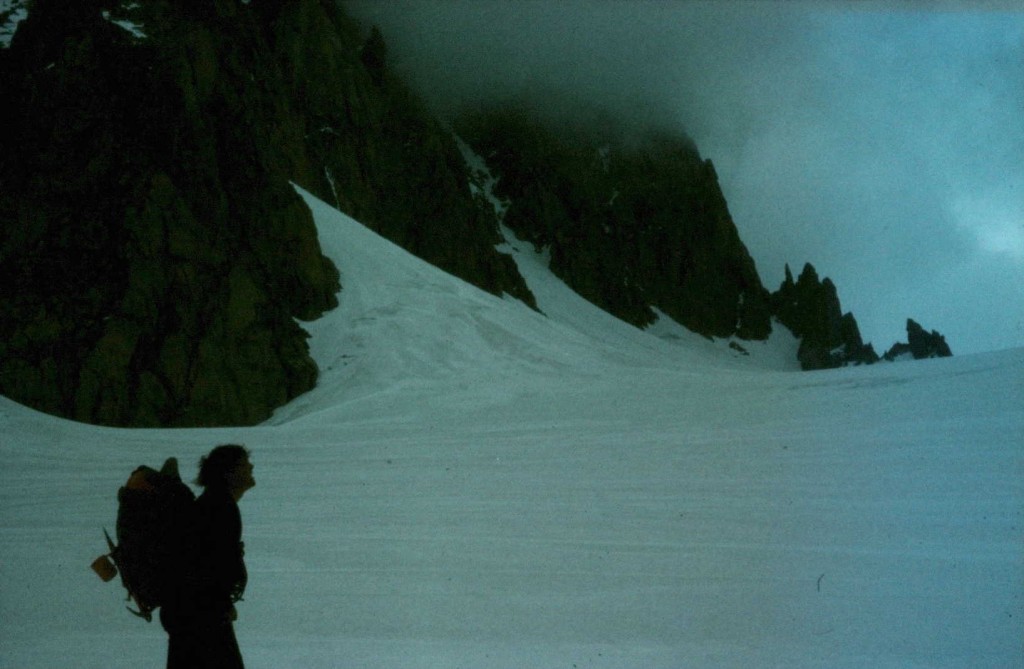
On the glacier with a rising star of 1980s English alpinism, Mark Miller. Note the strategically attached mug. The weather is closing in, but at least we can have a nice cup of tea.
Autumn came, and back in Cambridge the final year of my physics degree got going. What happened then was that, slightly to my surprise, I started to find the physics I was learning really fascinating. If the second year of my course was about the classical physics that had been embalmed in text-books for 50 or 100 years, now the physics we were learning seemed alive, contested and contestable. What before had seemed about learning some formal mathematical techniques, now seemed to revolve around recognising how to execute the subtle conceptual shifts that make seemingly intractable physical problems suddenly seem obvious and straightforward. All of this was helped by some teachers who in their different ways really were inspirational. Gil Lonzarich still stands out in my memory for his quietly compelling lectures, from which I learnt to appreciate the beauty at the heart of the apparently dry subject of statistical mechanics. A later set of lectures by Lonzarich on the physics of random and stochastic processes brought me face to face with deep, live, conceptual controversies in physics. My tutorials in the course came from that evangelical Bayesian, Steve Gull, who would generally begin each session by asking me what rubbish I’d been taught that week, and then go on to explain how poor Dr Lonzarich’s hopeless confusions would be swept away if he’d only acknowledge the subjective character of probability and follow the true Bayesian light pioneered by his hero Ed Jaynes.
It wasn’t that I didn’t think about climbing. There was a half-baked plan, not really taken seriously, to go and make a winter ascent of the North Face of the Matterhorn with my fellow student Jonathan Sharp. A New Year trip to the north face of Ben Nevis did result in me getting in one decent ice-climb, but was marred by bad weather and the sobering experience of helping to stretcher off a young woman hill walker, seriously injured after a long fall, dead before the helicopter arrived. Mark Miller (undistracted by any job or study commitments) was keen to get out to the Alps (winter alpine climbing then being popular as an affordable way of increasing one’s suffering level in the mountains without the inconvenience of having to visit the greater ranges). He achieved this ambition by getting a temporary job – which came with an apartment – as a bin man in a skiing development in Chamonix. This small apartment then housed a large and floating population of impecunious climbers, who between them got the bins emptied in between doing some hard routes. But not me – by that time it was out of the question that I would do anything but finish my course.
And by then, my thoughts were beginning to turn to the idea of going beyond just finishing my degree, and wondering whether I could go further in physics. It was the complexities of condensed matter physics that I was finding increasingly fascinating; a project on 2-dimensional disordered semiconductors and Anderson localisation gave me some flavour of what research in this area looked like. I’d fallen in with a group of three other students on the course with similar interests; a kind of self-help group, we shared notes and studied together, and started to look around the department to see what opportunities for PhDs there might be. We narrowed down the choices between semiconductor physics, surface physics, low temperature physics and polymer physics. In the end I wound up choosing polymer physics, under the supervision of Jacob Klein (who had taught me in my first year). Very soon the time came to take our final exams … and then find out the results. It was a source of both surprise and joy to find out that I’d achieved a first class degree (as had my three colleagues), my PhD place was confirmed … and Jacob Klein made me buy a copy of de Gennes’s book “Scaling Concepts in Polymer Physics”, and promise to read it over the summer. I did (though I was astonished that any book could cost as much as that one did, £42 in 1983).
I hadn’t completely forgotten about alpinism. I think I had a vague plan to go back to Chamonix, but I hadn’t got as far as booking the bus ticket. Then I heard the awful news that my friend Jonathan Sharp had been killed doing the Cordier pillar, the route on the Grands Charmoz I’d done myself the year before. He’d done the route, and then descended it by abseiling directly down the whole route, only to slip after coming off the rope at the bottom, to fall into the bergschrund (the big crevasse separating the main face of the mountain from the glacier below). This crystallised all my hesitations about revisiting Chamonix, I simply didn’t have the heart to do it that summer.
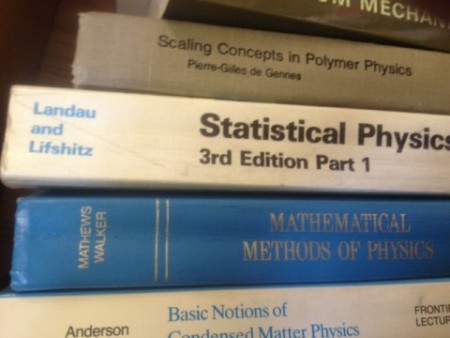
“There are other Annapurnas in the lives of men”. In the case of Mathews and Walker, I failed to summit.
I did go out to the Alps one more time, in the summer of 1985, with Mark Miller and two of his other friends. Mark and his climbing partner Simon Richardson disappeared to do another project on the high and remote side of Mont Blanc, leaving me with Sean Smith, another of the alpine binmen. We did the Jager Couloir, on the same face of Mont Blanc du Tacul as the Gabarrou Couloir. It’s a good route, easier and less technical than the Gabarrou, and we got up it fine. But I was less fit than I’d been two years previously, and it was harder work than I’d have liked, while for Sean, already a fine alpinist with experience of the alps in winter and a trip to the Himalayas under his belt, it was not enough of a challenge. So this, the last big route that I did on a glaciated mountain, was an anticlimax.
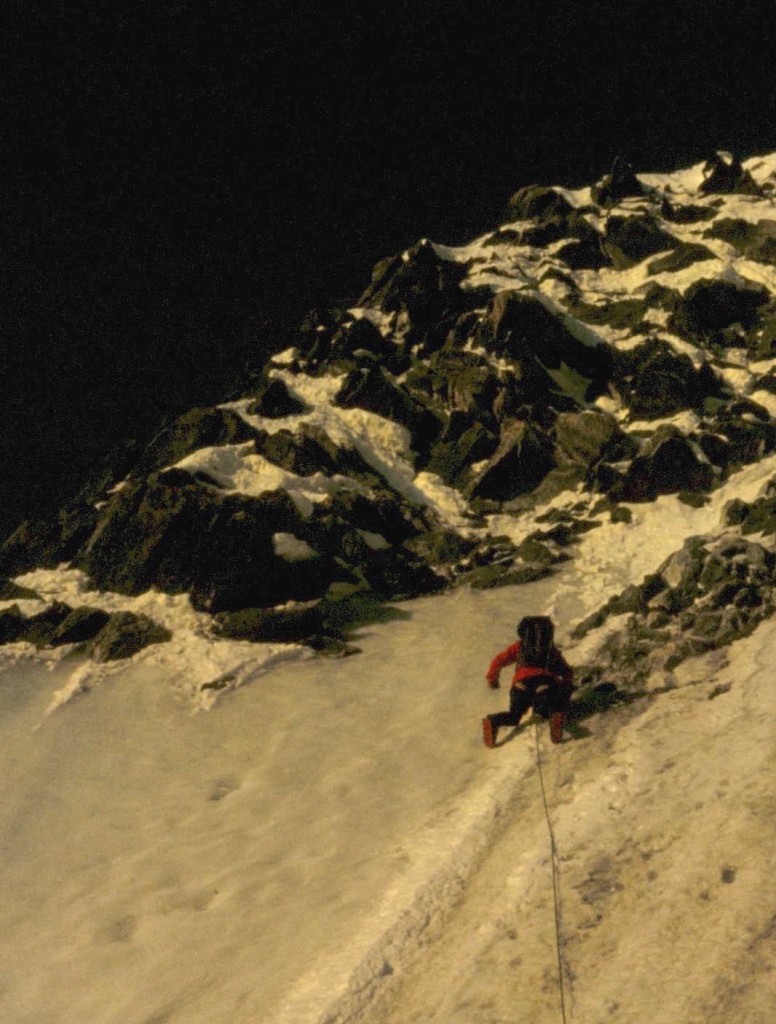
Sean Smith approaching the mixed ground at the exit from the Jager Couloir, E. Face of Mont Blanc de Tacul
Some years later – in September 1992 – I was back in Cambridge as an under-confident physics lecturer, with my own little house off Mill Road, when I had an uncharacteristic morning phone call from a friend. Had I seen the previous evening’s news about a plane crash on the approach to Katmandu? Mark Miller was on that plane, and there were no survivors. So I cycled to the lab with a hollow feeling. Mark’s and my paths had diverged that summer ten years previously, but I’d always stayed in touch with him, often staying with him in Sheffield, sometimes going rock climbing with him in the UK when he was back from one of his frequent trips to the Himalayas. He’d been a wild youth, disreputable and even reckless in all sorts of ways, but enormously charismatic. He’d become a renowned Himalayan mountaineer, a strong and safe climber on the mountain, who’d developed a special affinity with the remoter parts of Pakistan and Soviet Central Asia. Over the years he’d grown up too, setting up his own business leading guided expeditions to the greater ranges, and settling down in a house in Sheffield with his partner. I miss him still.
Climbing was important to me long after that summer (and it still is, even though sometimes at the moment that seems more in theory than actuality). But of all the climbing I have done, perhaps the memories I treasure most are of those few hours on the Gabarrou Couloir. It’s a long time ago, but even now I vividly recall the intensity of the physical experience – the cold ice, the thin air, the blue skies, and the hard red granite. I recall the sense of control, the self-confidence of body and mind in a steep place. And perhaps above all sharing both the difficulties and discomforts and the elation of success with a dear friend. I wasn’t going to be a mountaineer – I lacked the talent technically, I wasn’t physically and mentally tough enough, and perhaps, above all, I didn’t want it enough. Nor was I destined to be a successful theoretical physicist – I was never gifted enough mathematically, and, once again, I didn’t want it enough. I think I would have been surprised, back in the summer of 1982, at how things have turned out for me since, but I’m sure those choices that I made or were made for me were the right ones.
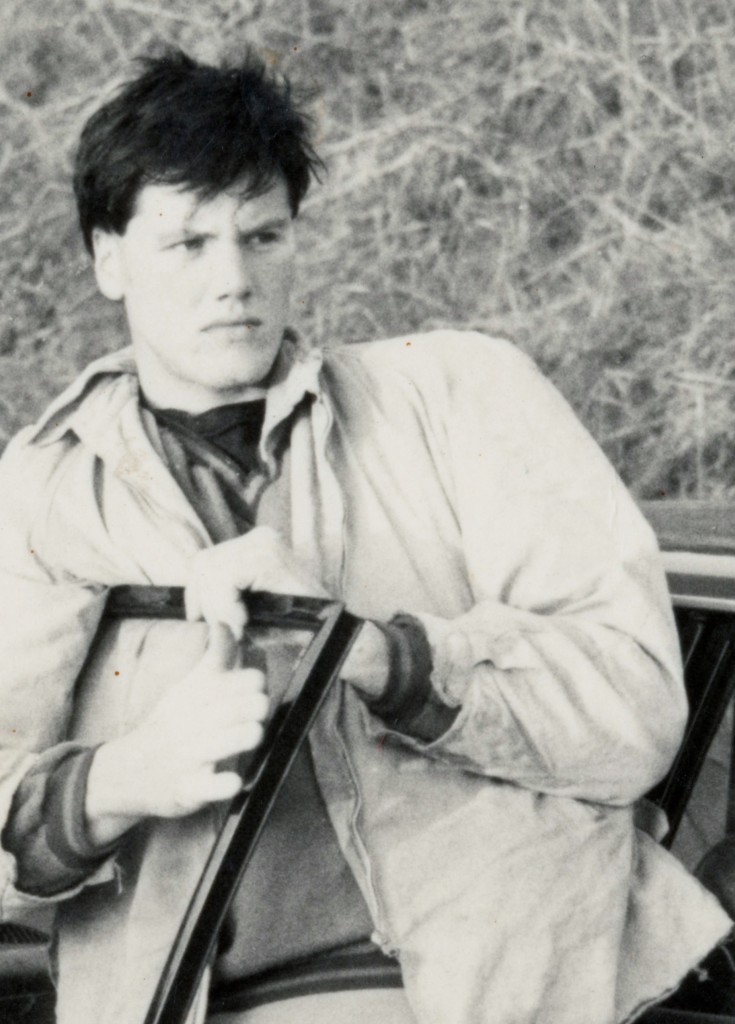
Thank you for sharing this personal, and touching, experience of falling into your place in life.
You’ll be pleased to hear, though perhaps little surprised, that my own supervisions with Steve still started exactly the same way in the late 2000s.
I went to look at the graph in the following post but was entranced by this reflective story.
What a wonderful and moving story.